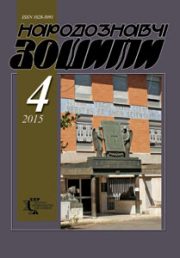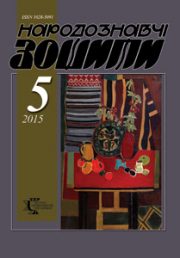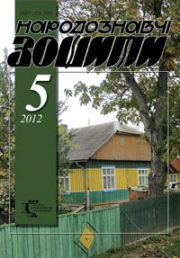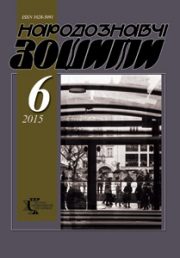The Ethnology Notebooks. 2018, 2 (140), 448—453.
UDK 745.52:7.071.1
DOI https://doi.org/10.15407/nz2018.02.448
Received 13.02.2018
MODERN AND TRADITIONAL ASPECTS IN THE CARPETS OF OLENA AND OLHA KULCHYTSKY
ORCID ID: https://orcid.org/0000-0003-0340-5436
Jamborko Olha, Candidate of Sciences in Art Studies,
Associate Professor
of the department of design and theory of art,
teacher of Institute of arts of the Prykarpattya national university
of the name of Vasyl Stefanyk.
Street of Shevchenko, 57, Ivano-Frankivsk,
Ivano-Frankivsk area, 76000.
Contacts: e-mail: kalyna015@gmail.com ; tеl. 0671391478.
Abstrakt. Carpets and rugs of the Kulchytski sisters as true samples of the «Ukrainian style» of the first third of the XX century are disclosed in the article. Sources of the sister’s creative heritage are highlighted. It reveals the influence of Finnish design on the early stage of the development of Olena Kulchytska’s artistic style. Ukrainian folk art is considered as a source of incipience of unique mature style of Olena and Olga`s Kulchytski carpets.
Keywords: carpets, rugs, art textile, Finnish design, Ukrainian style, Olena and Olha Kulchytski.
REFERENCES
Voloshyn, M. (2012). Stanovlennia osobystosti ta formuvannia svitohliadu Oleny Kul’chyts’koi. Narodoznavchi zoshyty, 6 (108), 1218—1228 [in Ukrainian].
Dobrians’ka, I. (1987). «Ya zhyvu zhyttiam moho narodu…»: Spohad pro Olenu Kul’chyts’ku. Zhovten’, 9, 127—130 [in Ukrainian].
Zabytkivs’ka, L. (2007). Vystavka tvoriv Oleny Kul’chyts’koi v Natsional’nomu muzei u L’vovi. Halyts’ka brama, 9—10 (153—154), 36—39 [in Ukrainian].
K-a, S. (1927). Ukrains’ke Narodnie Mystetstvo. Nova Khata,1, 18 [in Ukrainian].
Kost’, L. (2007). Vidrodzhennia tradytsij. Olena Kul’chyts’ka. Halyts’ka brama, 9—10 (153—154), 26—27 [in Ukrainian].
Kost’, L. (2007). Zhyttia u tvorchosti. Halyts’ka brama, 9—10 (153—154), 2—8 [in Ukrainian].
Kost’, L. (2007). Uzhytkove mystetstvo Oleny Kul’chyts’koi. ArtKlas, 3—4, 139—154 [in Ukrainian].
Pecheniuk, T. & Semchshyn, O. (1998). Do pytannia rozvytku khudozhn’oho tekstyliu Halychyny pershoi polovyny XX stolittia. Khudozhnij tekstyl’: L’vivs’ka shkola. L’viv: Polli [in Ukrainian].
Popovych, V. (1972). Olena Kul’chyts’ka. Avanhard, 6, 355—367 [in Ukrainian].
Stefanivs’kyj, Yu. (1991, 237, 13 hrudnia). Mystets’ko-promyslova spilka «Hutsul’s’ke mystetstvo». Svoboda: Ukrains’kyj schodennyk. Dzherzi Siti; N’iu-Jork [in Ukrainian].
Yamborko, O. (2016). Ornamental’nyj kylym. In Kara-Vasyl’ieva T. (Ed.) Istoriia dekoratyvnoho mystetstva Ukrainy: u 5 t. (Vol. 5, pp. 45—54). Kyiv: NAN Ukrainy, IMFE im. M.T. Ryl’s’koho [in Ukrainian].
Yamborko, O. (2016). Tematychnyj kylym. In Kara-Vasyl’ieva T. (Ed.) Istoriia dekoratyvnoho mys-tetstva Ukrainy: u 5 t. (Vol. 5, pp. 55—64) Kyiv: NAN Ukrainy, IMFE im. M.T. Ryl’s’koho [in Ukrainian].
Ashby Charlotte. (2010). National Building and Design: Finnish Textiles and the Work of the Friends of Finnish Handicrafts. Journal of Design History. Oxford University Press (Vol. 23, № 4, pp. 351—365) [in English].
Kirk Valerie. (1999). Scottish tapestry tradition, technique, narrative and innovation: its influence on Australian woven tapestry 1976—1996. A thesis submitted in partial fulfillment of the requirements for the award of the degree Master of Arts (Honours). University of Wolongong [in English].







